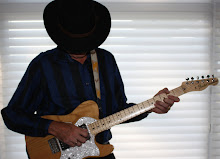I've already described how I thought The Beatles belonged in Ohio to reflect their
twin influences of Nashville
and Motown, and how Cat Stevens sounds to me like a blend between Memphis and
Motown.
The Stones? Chicago and
Memphis, so they're neighbours of the Cat.
Eric Clapton's ancestors came from The Delta, Chicago and Texas, placing him somewhere on the Arkansas/Oklahoma border.
U2 and The Kinks split that Motown pop sensibility with a NY punk attitude, putting the somewhere in Penn state (OK, let's give U2 to Buffalo).
Bands like ELO and Queen blend that Motown pop gift with the Hollywood production thing (and jazz complexity), placing them squarely in the middle of the country.
Cream and The Animals blended their love of Chicago blues with a touch of California weirdness, making them natives of Colorado (there you go Denver). Zeppelin: about the same but with a pull from The Delta.
Deep Purple and Pink Floyd have lots of the Hollywood production and complexity, with a bit of pull from the eastern styles, which I guess lands them in the southwestern desert.
Eric Clapton's ancestors came from The Delta, Chicago and Texas, placing him somewhere on the Arkansas/Oklahoma border.
U2 and The Kinks split that Motown pop sensibility with a NY punk attitude, putting the somewhere in Penn state (OK, let's give U2 to Buffalo).
Bands like ELO and Queen blend that Motown pop gift with the Hollywood production thing (and jazz complexity), placing them squarely in the middle of the country.
Cream and The Animals blended their love of Chicago blues with a touch of California weirdness, making them natives of Colorado (there you go Denver). Zeppelin: about the same but with a pull from The Delta.
Deep Purple and Pink Floyd have lots of the Hollywood production and complexity, with a bit of pull from the eastern styles, which I guess lands them in the southwestern desert.
Neil Young lands in West
Virgina (sorry Winnipeg), given an equal pull from Nashville and NY. And yes, I
know he's Canadian.
Elvis Costello? A bit more NY punk.
Dire Straits? Nashville, Memphis, Delta.
Van Morrison: Memphis, Delta (maybe a bit of Motown?)
David Bowie was tough. NY punk and Motown pop pulling hard against California - landing him in Nashville of all places.
Hmmm ... there's a whole new twist on the idea of "Music City."
Elvis Costello? A bit more NY punk.
Dire Straits? Nashville, Memphis, Delta.
Van Morrison: Memphis, Delta (maybe a bit of Motown?)
David Bowie was tough. NY punk and Motown pop pulling hard against California - landing him in Nashville of all places.
Hmmm ... there's a whole new twist on the idea of "Music City."


